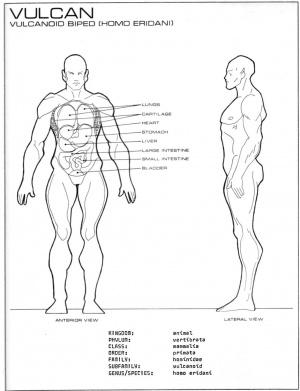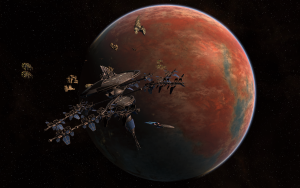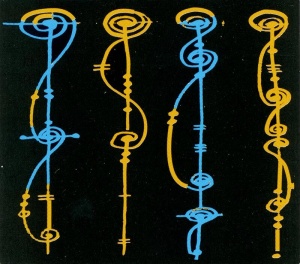Vulcan
From Star Trek: Theurgy Wiki
The Vulcans were a stoic, rational people. Widely claimed to be emotionless, in truth the Vulcans felt deeply and intensely, to their own detriment. Their stoicism came from a culture of logic and self-discipline, where emotions were analyzed and dissected to rob them of their potency so that they could not overwhelm or control the individual. Vulcans embraced science and reason, but their lives were not purely devoted to logic: they also had a deeply philosophical side, with art and music as vital to their culture as logic. They were also intensely private people, with many aspects of their culture — such as the rites of Pon Farr — which were not discussed amongst outsiders.
Psychology
Vulcans exalted logic over emotion and usually repressed or sublimated emotions in their daily behavior. Vulcans who dealt with non-Vulcans on a regular basis often maintained an almost glacial calm, possibly as self-defense against so much unguarded feeling. Among themselves, however, Vulcans usually seemed more relaxed; Vulcan ambassadors often cultivated a kind of distant good humor and politesse. Even Vulcan ambassadors, however, had trouble predicting or depending upon the behavior of more emotional species.
Physiology
Vulcans closely resembled Humans, with the same average height and weight. Their pointed ears were slightly larger than the Human norm, and their slanted eyebrows sometimes gave them a questioning look. The inner, or nictitating, eyelid was not visible. Vulcan skin complexions ranged from olive to dark mahogany, with a green cast provided by their copper-based blood. The Vulcan heart rested in the lower center of the torso, surrounded and protected by highly efficient lungs.
Externally Vulcans seemed to have much in common with Terrans, Vulcan internal physiology is quite different.
Body Size and Shape
Males and females were of similar height and stature, averaging 2 meters in height and 70 kilos in weight. Although their structure and frame were of similar height to those of Terrans, their strength was derived from longer muscle mass and a dense skeletal frame, the consequences of evolution in Vulcan's higher gravity and thinner atmosphere. One other significant difference from Terran physiology was the distinct lack of Vulcan sweat glands. Vulcans used blood, skin, and body structure to cool themselves rather than perspiration, which would have been inefficient given the high temperatures on the planet Vulcan.
Skin
Vulcan epidermis was unlike any other in the galaxy. Forming a two-way moisture-proof shield, it protected Vulcans from external liquids and pressure, as well as maintaining the inner temperature and liquid environment of their organs. Because Vulcan blood was copper-based rather than iron-based, it was green in color and was extremely effective in separating and utilizing the smaller amounts of oxygen available in Vulcan's low-pressure mildly irradiated environment. Due to this specialization of their blood and blood cells, Vulcans could survive for several minutes under water or in any oxygen-poor environment, as long as there was a small amount of oxygen available.
Brain
Not much was known about the Vulcan brain, although it was clear from even the simplest autopsy that the Vulcan midbrain is larger and more complex, and contains more nerve endings and blood capillaries than similar areas of Terran brains. The only other major species known to have possessed such a large percentage of midbrain was the Betazoid race, whose midbrain comprises nearly 65% of their entire brain mass. Vulcan midbrains were significantly smaller, averaging only 45% of the organ, yet this is still much more than comparative races. It was assumed that the majority of Vulcan psionic powers came from this enlarged region, although testing has been inconclusive.
Eyes
A clear inner eyelid formed of a nictitating membrane that filtered radiation, dust, and other harmful elements protected Vulcan eyes. Vulcan range of vision was more acute, as was their ability to recognize color frequencies and perceived more clearly at a distance. This seemed to have certain negative drawbacks as many Vulcans describe painful symptoms, similar to headaches and eyestrain, from being exposed to vibrant high colorations for long periods of time. The Vulcan optic nerve, much more delicate and sensitive than a typical Terran nerve, was more prone to disease and degeneration.
Ears
One of the most commonly noted differences between Terran and Vulcan physiology was the shape and structure of the earlobe and the functioning of the Vulcan inner ear. Although the Vulcan ear shape helped to funnel sound and intensify the reception of harmonics, the internal structure of the eardrum is very different, formed of no fewer than three separate functioning eardrums. These eardrums seemed to respond to differing volume and pitch, relaying the sound through separate channels to the nerve centers of the brain. Each worked independently, and in Vulcans of advanced age it was most often the low-pitched eardrum that deteriorates.
Skull
Vulcans had only 28 teeth, lacking rear molars and possessed a longer mandibular movement than most bipedal species. Although the bone structure of the Vulcan skull is thinner, the actual skull casing was formed of extremely dense matter, allowing a thinner depth of bone actually to be harder and stronger than a human skull.
Heart
Vulcan internal organs tended to operate at a much faster rate than those of comparable species, with an average heart rate as 265 beats per minute. The Vulcan heart lied in the center of the torso, surrounded by a large lung structure, capable of holding approximately 20% more capacity than Terran lungs. The Vulcan torso, ribcage, and musculature were also significantly longer, in order to encompass the organs within.
Vulcan hormonal activity was under muscular control and could be regulated by conscious processes of trained Vulcans. Thus, it was possible that a Vulcan could control his adrenaline, thyroid, and other metabolic systems, causing a change in heart rate, oxygen consumption, and other bodily resources. This accounts for the amazing Vulcan capacity to "regenerate" wounds, using a special trance state in order to repair any internal or structural damage more efficiently. The one primary exception to this rule was the reproductive hormone complex released during the Pon farr, in which a hormone known as yamareen was released into the bloodstream of the mature male Vulcan. Although the female Vulcan be impregnated after her menstrual cycle began (typically as early as age 16 and as late as 25), the male Vulcan was incapable of creating progeny until after the onset of his first pon farr. Thereafter, the Vulcan male is capable of reproducting, but must obey the physical urge to mate every seven years, during the pon farr. Vulcans, humans, and Klingons were all interfertile, giving credence to theories that all three races sprang from common ancestors seeded by the Preservers.
Reproduction
The biological and anthropological origins of pon farr remained unclear, and Vulcan modesty defeated Vulcan curiosity, leaving the subject mostly unstudied. The secretion of a hormone complex known yamareen caused the pon farr, or mating cycle. Difficult to produce scientifically, all attempts to create yamareen in laboratory experiments were unsuccessful. In the prehistoric phase of Vulcan, men fought to the death regularly for the right to mate with females. This kept the population down (useful on a desert planet) and ensured that only the strongest survived to reproduce. It also hindered the growth of Vulcan society, as men would not cooperate with others who could soon be their deadly enemies.
Pon farr occurred every seven years, regardless of physical condition or the Vulcan's social capacity to mate. Those who felt the "blood stirring" did not always have the luxury of being ceremonially joined to another Vulcan. In this case, they were free to choose their mate as they saw fit, hoping that they would be accepted. If a Vulcan was rejected or if his pon farr is allowed to continue without mating, he was said to suffer from plak tow, the "blood fever."
Plak tow was extremely dangerous and could result in death if not carefully controlled. Those around a plak tow sufferer would not speak his name out of courtesy. Ideally, this was the Vulcan way of "ignoring" the incident's occurrence at all, allowing the sufferer to endure with a minimum of stigma from other Vulcans. This habit caused many deaths because a series of intense meditations and rigorous physical disciplines was required to survive an unrequited plak tow, and even those methods were not always successful.
Vulcans reverted to ancient mating ceremonies during their pon far, attempting to cover their emotional abandon with logic and ancient ritual. The parents of both parties, as well as representatives from the School of Surak or other religious orders, oversaw the mating contract. This ritual began well before puberty, to minimize irrational behavior and channel it toward social cohesion rather than the rutting madness that split Vulcan apart during its prehistory.
At age seven, Vulcans ceremonially bonded telepathically with their betrothed. This tradition dated back to the early, violent days of Vulcan history, when great families arranged marriages for convenience and alliance. Some families, notably those who were old, wealthy, or influential, held to this tradition, called koon-ul, "the joining." At the proper time, both individuals felt the strange rise of emotions, the nearly uncontrollable urges and overwhelming passions, signaling the star of pon farr. Other less traditional, Vulcans simply relied on shon-ha'lock, "the engulfment," to direct them to a mate at the proper time. This experience, although similar to human "love at first sight," was seen by most Vulcans as a dangerous but necessary experience, much like kahs-wan.
During pon farr, the two betrothed parties met at a ceremonial ground (usually the one belonging to the more influential family) and engaged in the rite of Koon-ut-kal-if-fee, "marriage or challenge." Here, the bride had the right to demand that the groom win her in mortal combat with a champion. (Some versions of the ritual allowed the bride herself to serve as her own champion in combat.)
Koon-ut-kal-if-fee was a survivor of ancient Vulcan customs from times when the great houses used marriages as tests of military and political strength. In modern times, a formalized question replaced this rite and the ceremony goes forth as planned. Koon-ut so'-lik, the formal marriage proposal, could occur during the koon-ul, at the beginnning of the mutual pon farr, or even at the conclusion of the ceremony. Althought much of the pon farr was public, the deep emotional nature of the situation caused Vulcans to shield it from the prying eyes of other races.
This was but one aspect of the Vulcan traditional reserve, stemming from a cultural fear of emotional vulnerability and exposure called k'oh-nar.
Homeworld
The planet Vulcan (or Ti-Valka'ain, in the Vulcan language) was the second plant of six orbiting the orange star 40 Eridani A (part of a trinary system; the other two stars were too far away to be immediately visible in Vulcan's sky). Vulcan was a harsh, desert world (barely a quarter of the surface area was water) with a thin atmosphere and high (1.4 G) gravity. Vulcan's geology produced starkly upthrust mountains: craggy, inhospitable, and inspiring to the planet's ascetic logicians and mystics alike. The capital city of Vulcan, ShirKahr, was a low, stark city laid out in logical grids and quarters around an ancient oasis.
Vulcan Ecology
Temperature and Climate
Flora and Fauna of Vulcan
Geography
Culture
Art
Architecture
Cuisine
Religion
The Twilight of the Gods
The Inner Chorus
T'plana-Hath and the Birth of Vulcan Logic
The School of Surak
The Way of Jarok
The School of Nirak
The One Mind School
The Kolinahr Path
The Hakihr Way
Katra: The Vulcan Soul
History
The Age of Antiquity
The Time of Awakening
Rift with the Proto-Romulans
The Golden Age
The Romulan War
To the Stars
First Contact with Humanity
The Federation
Government
The Vulcan Council
Elections and Impeachment
Council Functions
The Ministry of State
The Ministry of Defense
The Ministry of Security
The Ministry of Health
The Ministry of Thought
The Ministry of Science
The Ministry of Trade
Vulcan Diplomacy
The Vulcan Isolationist Movement
Language and Names
Vulcan and Federation Standard was the dominant language spoken by Vulcans.
Vulcans used only given names, though in ritual greetings they added their parent's name (and sometimes more), as in Spock, son of Sarek, son of Solkar. Even Vulcans of extremely ancient and powerful families used no honorifics; aristocracy was illogical, and logically, anyone worth impressing should already know who you were without being reminded of your family's status.
Male Names
Delvok, Kov, Lojal, Sakar, Sakkath, Sanshiin, Sarek, Satelk, Satok, Savar, Skon, Solkar, Solok, Sonak, Sopek, Soral, Soval, Spock, Stonn, Surak, Sybok, Tavin, Tolaris, Tuvok, Vanik, Vorik
Female Names
Saavik, Sakonna, Selar, Senva, Sitak, T'Lar, T'Lara, T'Pan, T'Para, T'Pau, T'Pel, T'Penna, T'Pera, T'Plana-hath, T'Pol, T'Pring, T'Shanik, Tallera, V'Lar, Valeris
Species Abilitis
Reference works used in creation of this page
Information & images found on this page have been compiled from many sources on the Internet.
1. http://en.wikipedia.org/wiki/Star_Trek
2. http://memory-alpha.org/en/wiki/Vulcans
3. http://www.vulcanlanguage.com/
4. http://www.ditl.org/
5. http://www.ex-astris-scientia.org/history.htm
6. http://www.geocities.com/shirkahr/VulcanTimeline.html
7. http://www.ccdump.org/
8. http://www.starbase118.net/wiki/index.php/Vulcan_(planet):_The_Provinces_of_Na’nam
9. http://www.geocities.com/shirkahr/ShirKahrCity.html
10. http://www.projectrho.com/vulsun.htm
11. “The Way of Kolinahr” by Last Unicorn Games
12. “Sarek” by A.C Crispin
13. “The IDIC Epidemic” by Jean Lorrah
14. “Spock’s World” by Diane Duane




